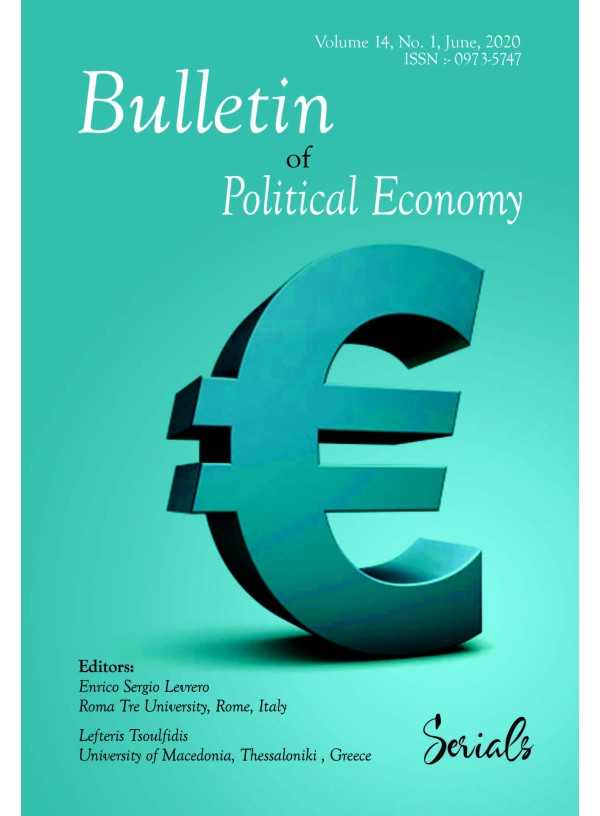
Bulletin of Political Economy
- ISSN :- 0973-5747
- Frequency :- Semi-annual
Articles
Kaldor after Sraffa
Author :- Óscar Dejuán
Volume :- No.13 (2019)
Issue No :- 1 (2019)
Pages :- 1-19
Kaldor led the postKeynesian school in an attempt to project Keynes’ principle of effective demand into the long run, the realm of growth theories. This paper examines Kaldor’s major contributions to growth, technical change, distribution and money, in order to integrate them into the surplus approach. An approach that combines the classical- Sraffian theory of value and distribution with the KeynesianpostKeynesian theory of output and money. An approach that considers capitalism as a demand- constrained system, both in the short run and in the long run, without neglecting the limits derived from the supply side.
Keywords: Surplus approach; principle of effective demand; growth and distribution; supermultiplier; Sraffa; Kaldor
JEL Codes: B24, E11, E12
Endogenous money theory: horizontalists, structuralists and the credit market
Author :- Matteo Deleidi
Volume :- No.13 (2019)
Issue No :- 1 (2019)
Pages :- 21-53
This paper provides an empirical investigation of the endogenous money theory and of the internal debate between horizontalists and structuralists. To do this, SVAR models are implemented on monthly data for the euro area for the 2003–2017 period. The findings show that (i) the volume of loans is mainly affected by the level of demand rather than by credit supply conditions; (ii) the mark-up on bank loans is an exogenous variable, independent of the demand for credit and the volume of loans granted by banks; (iii) commercial banks are generally able to counterbalance a fall in profits – for example, driven by a price increase or a narrow credit supply conditions – through an increase of the mark-up; and (iv) an increase in the rate of growth of the economy reduces the mark-up by lowering the risk perceived by banks. These findings confirm both the relevant role played by demand forces in determining the banks’ loans and the horizontalist approach.
Keywords: Endogenous money theory; Horizontalists; Structuralists; Eurozone; SVAR.
JEL: E40, E50, E51, G21, C32.
A bit of Keynesian debt-to-GDP arithmetic for deficit-capped countries
Author :- Stefano Di Bucchianico
Volume :- No.13 (2019)
Issue No :- 1 (2019)
Pages :- 55-83
This paper expands some recent Keynesian debt-to-GDP arithmetic exercises in three respects. Firstly, it analyses the output and capacity losses associated with a ‘balanced budget’ fiscal policy. Secondly, the possible Keynesian features of a policy looking at the difference between the growth rate and the interest rate are also discussed, showing a condition which allows for a debt-to-GDP ratio reduction via primary deficit spending. Lastly, the minimum necessary fiscal multiplier values needed to make austerity policy counterproductive are calculated for the PIGS economies covering the 1998 – 2018 period. The results show the substantial case for the Keynesian arithmetic to hold.
Keywords: Public debt, debt-to-GDP ratio, fiscal policy, fiscal multiplier
JEL Codes: E62, H62, H63
Decoupling Entrepreneurship Capital from Capital Stock
Author :- Dennis Ridley & Abdullah Khan
Volume :- No.13 (2019)
Issue No :- 1 (2019)
Pages :- 85-94
Per capita real gross domestic product adjusted for purchasing power parity (G) is parsimoniously explained by capitalism (C), democracy (D) and rule of law(R). G is estimated from a CDR index equal to the vector inner (dot) product of global invariant parameters [1.53 0.14 0.23 -1.21] and country specific [C D R C·D·R]. The data a re for year 2014 and 79 countries that represent practically all people in the world. C is measured by total capitalization then split into human capital of entrepreneurship imagination and creativity and capital stock of knowledge, machines, computers, training, recording devices etc. The contribution of entrepreneurship to G is found to be 6 times that of capital stock.
Keywords: CDR index; GDP; Capitalism; Democracy; Rule of Law; Entrepreneurship
JEL: E02, P16
